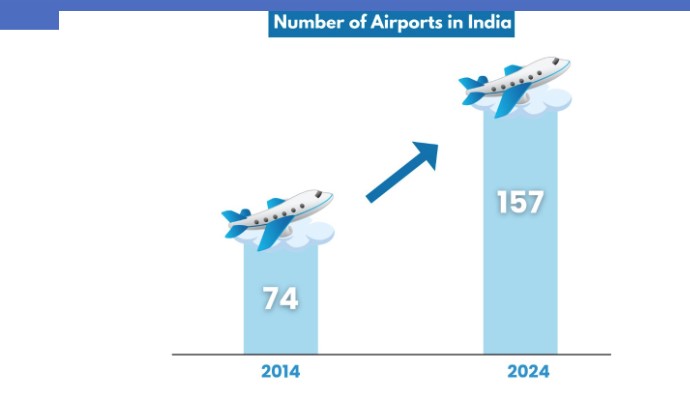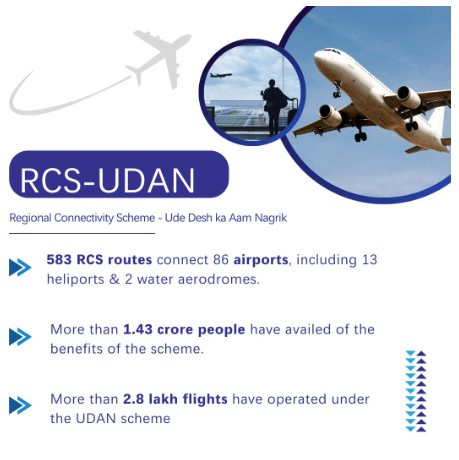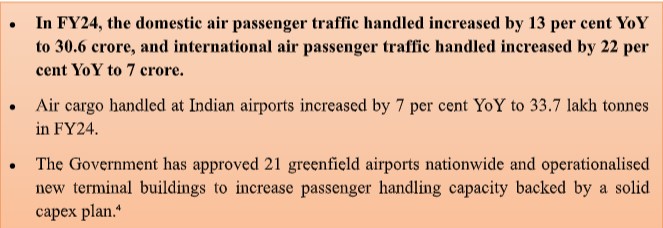Others
India's Soaring Skies with Inclusive and Booming Aviation
Operational Airports Increased From 74 in 2014 to 157 in 2024
Posted On:
15 SEP 2024 5:08PM
“Today, India is among the top players in the global civil aviation ecosystem. In just one decade, India has achieved a significant transformation. In these 10 years, India has evolved from a country exclusive to aviation to one that is inclusive of aviation.”
~ Prime Minister Narendra Modi
India's aviation sector is experiencing a meteoric rise, fuelled by soaring demand and the government's unwavering commitment to its growth through supportive policies. The industry has undergone a remarkable transformation, shedding its previous limitations and evolving into a vibrant and competitive sector. This dynamic shift has propelled India to the forefront of the global aviation ecosystem, becoming the third-largest domestic aviation market in the world, after the USA and China.
The government's commitment to nurturing aviation growth has been instrumental in this success story. A series of strategic initiatives have been implemented, each designed to empower the industry and unlock its full potential.
 2nd Asia Pacific Ministerial Conference on Civil Aviation
2nd Asia Pacific Ministerial Conference on Civil Aviation
The 2nd Asia Pacific Ministerial Conference on Civil Aviation concluded on September 12, 2024, with the formal adoption of the landmark Delhi Declaration. Delhi Declaration sets a framework for enhancing regional cooperation, addressing aviation challenges, and fostering sustainable growth. Prime Minister Shri Narendra Modi said "Our aim is to bring air travel to the common people. We need to make air travel safe, affordable, and accessible to all. The declaration, along with everyone's efforts, will help us achieve that."
Prime Minister Narendra Modi highlighted India’s technological and infrastructure achievements in civil aviation and emphasized the importance of making the sector more inclusive for women. He noted that 15% of India’s pilots are women, significantly higher than the global average of 5%, and mentioned the issuance of an advisory to further increase this number. Reflecting on the transformation of India’s aviation sector over the past decade, he remarked that India had shifted from an exclusive aviation environment to one that is inclusive, connecting people, cultures, and fostering prosperity. He said that initially aviation might have been limited to a select group or used primarily by elites in big cities with good air connectivity, but over time, it has become more accessible and inclusive, allowing more people from various socio-economic backgrounds to participate in air travel due to various initiatives and policy changes introduced and implemented by the government. The sector has gone from serving a small, privileged section of society to being more widespread and affordable, benefiting the general population specially from Tier 2 and tier 3 cities.oactive Infrastructure Development

India's aviation industry has experienced significant growth in the past 10 years. The number of operational airports in the country has doubled from 74 in 2014 to 157 in 2024 and the aim is to increase this number to 350-400 by 2047. The domestic air passengers have more than doubled in the past decade, with Indian airlines significantly expanding their fleets.
The springboard for this growth has been the government’s policies and initiatives. One such initiative is the Regional Connectivity Scheme – Ude Desh ka Aam Nagrik (RCS-UDAN) launched in 2016, which aims to provide connectivity to unserved and underserved airports of the country through the revival of the existing airstrips and airports.
The Indian government is also placing a strong emphasis on sustainability. This is evident in the achievements of Delhi and Mumbai airports, both of which have been awarded the prestigious Level 4+ Carbon Accreditation. This recognition highlights their commitment to reducing their carbon footprint and promoting responsible aviation practices.
 Regional Connectivity Scheme – UDAN
Regional Connectivity Scheme – UDAN
At the heart of this expansion lies the Regional Connectivity Scheme (RCS) - UDAN (Ude Desh ka Aam Nagrik). The scheme has undergone several successful iterations over the past seven years, focusing on connecting underserved and unserved regions of India. By reviving existing airstrips and airports, UDAN aims to bring essential air travel access to previously isolated communities and boost regional economic development. With a ten-year operational plan, UDAN intends to ensure equitable access to air travel for all Indians.
RCS-UDAN is contributing to the growth of the civil aviation industry as four new & successful airlines have come up in the last 7 years. The scheme has helped airline operators to begin operations and develop a sustainable business model. Additionally, it’s providing opportunities to small regional airlines to scale up their businesses and their successful run is evidence of the fact that the scheme is creating an amiable ecosystem conducive to airline business.

The announcement of launch of the UDAN 5.3 was made at the inauguration of Wings India 2024. The largest event in the Civil Aviation sector in Asia, “Wings India 24” kickstarted in Hyderabad on 18 January 2024. Spanning across commercial, general, and business aviation, the theme for the show was “Connecting India to the World in Amrit Kaal: Setting the Stage for India Civil Aviation @2047”. The other major announcements made were:
- Release of the joint knowledge paper on civil aviation by FICCI and KPMG,
- Launch of the Airbus-Air India Training Centre, with the purchase of more airplanes and the setting of a flight training center in Gurugram with 10 flight simulators and 10,000 pilots being trained in the coming years
- Airbus manufacturing contracts with TATA ASL and Mahindra Aerospace Structures Pvt. Ltd. to foster more pilots.
- GMR and IndiGo also signed a consortium to collaborate with multiple patterns in developing sustainable training in the aerospace industry
- Inauguration of the GMR School of Aviation
- Deal announcement of Akasa Air with a triple order of 200 aircrafts in a period of 17 months
RCS – UDAN: Progress so far (Data as on Aug 31, 2024)
- 583 RCS routes have so far commenced operations connecting 86 airports including 13 heliports & 2 water aerodromes
- More than 1.43 crore passengers have availed of the benefits of the scheme.
- More than 2.8 lakh flights have operated under the UDAN scheme so far.
- Rs 4500 Crores have been allocated for the development of airports in the country under the Scheme, out of which Rs. 3751 Crores have been utilized since its inception.Passenger Growth

India is the third-largest domestic aviation market and the aviation sector in India has shown substantial growth, with a 15 per cent YoY increase in total air passengers handled at Indian airports reaching 37.6 crore in FY24.

 Carbon Neutrality Initiatives
Carbon Neutrality Initiatives
The Ministry of Civil Aviation (MoCA) has taken initiatives to work towards Carbon neutrality and achieving net zero carbon emissions at airports in the country by way of standardizing the Carbon Accounting and Reporting framework of Indian Airports. For this purpose, airport operators with scheduled operations have been advised to map the carbon emission at their respective airports and to work towards carbon neutrality and net zero emission in a phased manner.
MoCA is encouraging developers of new Greenfield airports, in collaboration with respective state governments, to prioritize carbon neutrality and net zero emissions in their development plans. As on July 25, 2024, 12 Greenfield Airports have been constructed/operationalised since 2014. 48 airports/airstrips have been constructed by AAI since 2014. With the efforts of the Government of India, Airports like Delhi, Mumbai, Hyderabad, and Bengaluru have achieved Level 4+ as well as higher Airports International Council (ACI) Accreditation and have become Carbon neutral.
The airport operators including Airports Authority of India (AAI) have installed solar power plants at various locations/Airports for generation and self-consumption of green and renewable energy to encourage green energy usage at the airports. In addition, few airports are also procuring green energy through open access. Since 2014, a total of 73 airports have switched over to 100% green energy usage.
India’s aviation sector is on a transformative path, with significant strides in infrastructure development, regional connectivity, and sustainability efforts. The success of initiatives like RCS-UDAN has enhanced access to air travel, promoting economic growth and connectivity in underserved regions. With an impressive rise in both domestic and international passenger numbers, India is poised to further strengthen its position as a global aviation hub. As the sector embraces greener practices, such as carbon-neutral airports and solar energy adoption, the future of aviation in India promises not only continued growth but also a commitment to sustainability, ensuring long-term benefits for the nation and the environment.
References:
Click here to see in PDF:
Santosh Kumar/ Sarla Meena/ Aswathy Nair
(Backgrounder ID: 152143)
आगंतुक पटल : 11689
Provide suggestions / comments